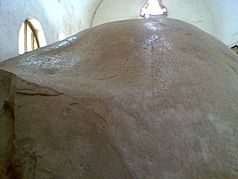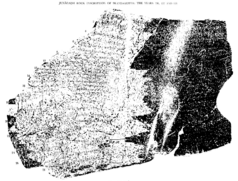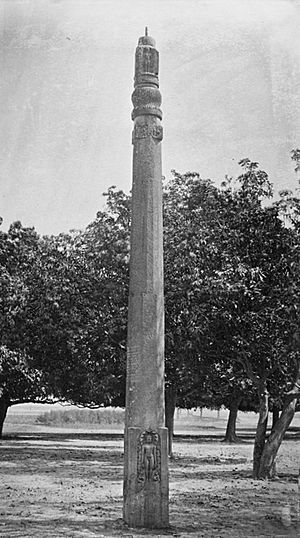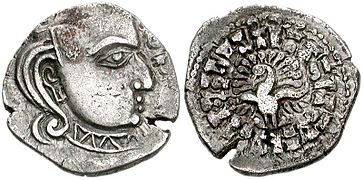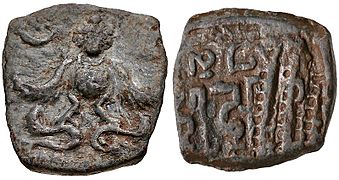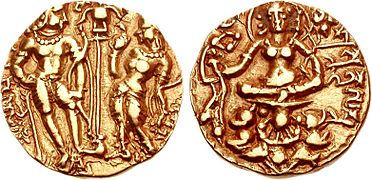Skandagupta facts for kids
Quick facts for kids Skandagupta |
|
|---|---|
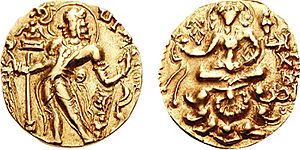
Gold coin of Skandagupta, depicting himself on the obverse, Lakshmi on the reverse. The name
|
|
| 8th Gupta Emperor | |
| Reign | c. 455 – c. 467 CE |
| Predecessor | Kumaragupta I |
| Successor | Purugupta |
| Dynasty | Gupta |
| Father | Kumaragupta I |
| Religion | Hinduism |
Skandagupta (reigned around 455-467 CE) was a powerful Gupta Emperor in ancient India. He is famous for saving the Gupta Empire from its enemies. One of his most important achievements was pushing back an invasion by a group called the Indo-Hephthalites, also known as the Hunas. He managed to keep control of the lands his family ruled. Many historians see him as the last great ruler of the Gupta Empire. After him, the history of the Gupta family becomes a bit unclear. It is believed that his younger half-brother, Purugupta, took over after him.
Contents
Early Life of Skandagupta
Skandagupta was the son of Emperor Kumaragupta I. His mother might have been a junior queen or a different kind of royal partner. This idea comes from his inscriptions, which mention his father but not his mother. For example, a famous inscription from Bhitari lists the main queens of his ancestors, but not his father's chief queen.
However, other historians disagree with this idea. They point out that the Bhitari inscription shows Skandagupta deeply respected his mother. It says that after he defeated his enemies and brought glory back to his family, he visited his mother. This was like the legendary hero Krishna visiting his mother Devaki. This comparison suggests his mother was held in high regard. It is more likely that the inscription wanted to show how Skandagupta raised his mother's status, just as Krishna did for Devaki.
Becoming Emperor
Skandagupta became emperor around 455-456 CE. The Bhitari pillar inscription tells us that he "restored the fallen fortunes of his family." This means the empire was in trouble, and he brought it back to strength. The inscription says he spent a night sleeping on the bare ground before defeating his powerful enemies. After his victory, he visited his mother, who was crying tears of joy.
Historians believe these enemies were either a tribe called the "Pushyamitras" or just a general term for "enemies" (Yudhyamitras). These enemies might have attacked the Gupta Empire when his father was old, or right after his father died. Skandagupta then defeated them.
Another idea is that the conflict was about who would become the next emperor. Here's why some historians think this:
- An inscription in Junagadh says Skandagupta became ruler by his own strength after his father's death. This could mean he had to fight for the throne.
- The Junagadh inscription also says the goddess Lakshmi chose Skandagupta as her husband, rejecting other princes. Some of his coins show a woman giving him a garland, which might show this story.
- The Bhitari inscription mentions the "fallen fortunes of the family" several times. This might refer to a fight over who would rule, rather than just an outside invasion.
- Other records show that several people claimed power after Kumaragupta's death. These people might have been rivals to Skandagupta.
Later Gupta kings sometimes left Skandagupta's name out of their family lists. This might be because they were descendants of his half-brother, Purugupta, and only wanted to list their direct ancestors.
Fighting the Hunas
During Skandagupta's rule, a group called the Indo-Hephthalites, also known as the White Huns or Hunas, invaded India. They came from the northwest and reached as far as the Indus River.
It is not fully clear when this invasion happened. The Bhitari inscription mentions it after the fight with the Pushyamitras, suggesting it was later in his reign. However, another inscription in Junagadh hints that it might have happened earlier, perhaps even during his father's rule.
The Junagadh inscription, from around 455-456 CE, mentions a victory against "mlechchhas" (a term for foreigners). Since Skandagupta is not known to have fought other foreign groups, these "mlechchhas" were likely the Hunas. If this is true, Skandagupta might have been a prince sent to fight the Hunas at the border. While he was away, his father might have died, and Skandagupta had to return to the capital to claim the throne from rivals.
An old Sanskrit text from the 7th century says, "The Gupta conquered the Hunas." This is likely talking about Skandagupta's victory. An 11th-century story also mentions a legendary king named Vikramaditya defeating foreigners after his father stepped down. Since Kumaragupta used the title Mahendraditya and Skandagupta used Vikramaditya, this story might also refer to Skandagupta's win over the Hunas.
Ruling Western India
The Junagadh rock has inscriptions from earlier emperors like Ashoka and Rudradaman I. Skandagupta also had an inscription carved there, ordered by his governor, Parnadatta. This inscription says Skandagupta appointed governors for all his provinces, including Parnadatta for the Surashtra region. It is unclear if these were normal appointments or if they happened after a war or struggle for the throne. The inscription also lists many good qualities needed to be governor of Surashtra, saying only Parnadatta had them all.
Parnadatta then made his son, Chakrapalita, the magistrate of the city of Girinagara (near modern Junagadh). This city was probably the capital of Surashtra. The Junagadh inscription records that Chakrapalita repaired the Sudarshana lake. This was an ancient water reservoir first built by Chandragupta Maurya and later improved by Ashoka. The dam broke around 456-457 CE. Chakrapalita spent a huge amount of money to rebuild the embankment. He also built a temple dedicated to the god Vishnu.
Another king, Narendrasena of the Vakataka kingdom, claimed that rulers in other areas obeyed him. Narendrasena was likely a contemporary of Skandagupta. Since one of these areas, Malava, was part of the Gupta Empire, Narendrasena might have attacked Gupta lands during Skandagupta's reign. However, Skandagupta would have quickly brought these areas back under Gupta control. An inscription from around 460-461 CE talks about the "peaceful reign of Skandagupta, the lord of a hundred kings."
Who Ruled Next?
The last known date for Skandagupta's rule is around 467-468 CE. He probably ruled for a few more years after that.
Most historians believe that Purugupta took over after Skandagupta. Purugupta was the son of Kumaragupta I and his chief queen, which means he was the rightful heir. It is possible that Purugupta was too young when Kumaragupta I died, allowing Skandagupta to become emperor. Skandagupta might not have had a son to inherit the throne, or his son might have been removed from power by Purugupta's family.
Skandagupta's Coins
Compared to the emperors before him, Skandagupta made fewer gold coins. Some of these coins also had less gold in them. This might be because the many wars he fought used up a lot of the empire's money, but we cannot be completely sure.
Skandagupta issued five different kinds of gold coins:
- Archer type
- King and queen type
- Chhatra type (showing an umbrella)
- Lion-slayer type
- Horseman type
He also made four types of silver coins:
- Garuda type (showing a mythical bird)
- Bull type
- Altar type
- Madhyadesha type
His first gold coins weighed about 8.4 grams, just like his father Kumaragupta's coins. These early coins are quite rare. Later in his rule, Skandagupta changed the currency. He started using a new gold coin standard that weighed about 9.2 grams. These later coins were all of the Archer type, and this new standard was used by all the Gupta rulers who came after him.
-
Coin of Skandagupta (455-467), in the style of the Western Satraps.
-
Coin of Skandagupta Kramaditya with facing Garuda.
See also
 In Spanish: Skandagupta para niños
In Spanish: Skandagupta para niños




